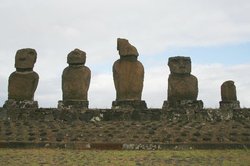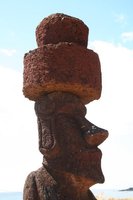Moai
Often called mo'ai, these are gigantic
stone monoliths located on Easter Island. Plural for the word moai is also moai. "Moais"
is incorrect.
887 moai can be found on Rapa Nui, but many
of them are in bad condition: tumbled, broken
or unfinished. Some statues are placed on
ahu platforms and others are either scattered
in groups on a wider area or are completely
alone. An ahu usually had many moai on it.
Many statues have shoulders and chest, some
have arms, some have fingers and a single
one even has legs.
397 of the statues are at the Rano Raraku
quarry with the remainder placed along the shores, except Aku Akivi
which is inland. The Moai face inland and
it is believed that the statues were positioned
that way to watch over the villages.
Specialists believe that the statues were
built between 1250 and 1500 AD but it is
still not known how exactly or why these
immense statues were built...
Characteristics and figuresStrangely, the moai statues are asymmetrical.
Their heads are 3/5 larger than their bodies.
It is believed that they represent locals,
ancestors of those who built them. Why they
were built is not known, but it is speculated
that they might have been constructed to
bring homage to the dead deified ancestors
of the Rapa Nui people.
They are built of hard volcanic rock, no-one
knows how they were carved out and placed
into position. The biggest moai is one that
was unfinished. If it were completed, its
size would have been 21.6 meters tall and
probably up to 270 tons heavy.
The largest to be erected is Paro of Ahu
Te Pito Kura, 10 meters in height, approx
80 tons. The heaviest moai is a shorter
one located at Aku Tongariki. It weighs 86
tons.
Only 1 of all moai statues has legs. This
is the famous small kneeling moai, called
Tukuturi. The material used for its carving
was red scoria rock from the place called
Puna Pau, yet he was placed near Rano Raraku.
Some believe that Tukuturi is related to
the Tangata Manu (Bird Man) cult. There are
specialists who think this is the last moai
made.
There are exactly 887 moai on Rapa Nui. 834
moai are made from tuff (compressed volcanic
ash), 13 from basalt, 22 from trachyte and
17 from red scoria rock (which is a softer
stone).
A total of 288 moai were successfully transported
to the ahu platforms. The Rapa Nui people
built special connecting roads for this purpose.
92 moai have been found in positions indicating
that they were in the transportation stage,
which for some reason was interrupted. Perhaps
because the trees left on the island were
insufficient for creating the necessary equipment
for moving them.
Interestingly some moai have complex eyes
made of 2 different types of rock. A whiter
rock for the eyeball and a black-coloured
obsidian rock for the pupil. Painting the
eyes would have been a lot easier, but for
some reason the craftsmen of Rapa Nui thought
that the statues would be more human-like
if they made white sockets into which they
insert the darker pupils.
The quality of work and current stage
Despite the hard volcanic rock material,
these statues are remarkably well carved.
With good precision, they somewhat resemble
each other, but one can see many different
faces among them. The faces are beautifully
carved, are true works of art.
Unfortunately during tribal conflicts many
of the statues were pulled down. At the time
when the first Europeans stepped on Rapa
Nui, the moai were still in place, intact.
Then, later visitors reported they have found
destroyed and tumbled moai.

AhuThese are the platforms upon which some of
the moai were placed. It is still unknown
why some moai are on platforms, lined up
side by side, while many are simply scattered
around the shores and in the Rano Raraku
area.
Each ahu is made of a large number of smaller
stones, which are put together in such a
way that they form a long platform on which
moai statues can stand. Often the ahu were
burial places where important personalities'
graves were built.
In total 313 ahu were built and only 125
were moai-carrying ones, most of which only
had a single statue on them. Some of these
platforms were destroyed during the tribal
wars, while Ahu Tongariki was swept inland
by a tidal wave (tsunami). Later many of
them were restored by specialists.
Interestingly there were several empty ahu
platforms found. Some speculate that there
might have been wooden moai as well, that
would have perished over time, maybe during
the conflict or because wood could not cope
with the weather for so many hundreds of
years. Another possibility is that when all
trees were cut down on the island, the locals
turned to the wooden moai and simply used
them as raw material.
The elements of the ahu:
reinforced back wall (usually faces the ocean),
on average over 1 meter high
front retaining wall
ahu-holding platform between the two mentioned
above with a stone slab on it for increased
resistance
inclined ramp in the front
pavement in front of the ahu
The inside of the ahu was rock-filled but
often there were burial chambers inside of
the ahu, under the inclined ramp.
The ahu were usually built close to the beaches,
very few were constructed inland. An inland
formation is that of Ahu Akivi for example.
But even this one isn't very deep inside
the island. It is not known why it was so
important to place the statues on the edges
of the land, close to the ocean.
The ahu are located distributed quite evenly
along the coast, especially on the northern
and eastern parts. Few or none are located
in the western parts.
It was reported in 1880 that there were several
moai on an ahu on Rano Kau's cliffs,
but the Routledge Expedition in 1914 found
them tumbled to the beach.

Pukao (Topknots)In English these are called "topknots"
and look like red hats on the heads of the
moai. Locally, these are considered to be
the ‘hair’.
The pukao were made of red scoria volcanic
rock, which is more fragile than the moai's
usual hard material. This is why many of
these hats broke easily when the statues
were pulled down during the conflict.